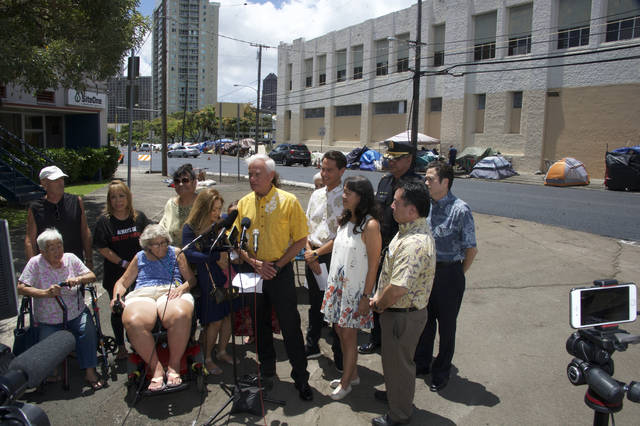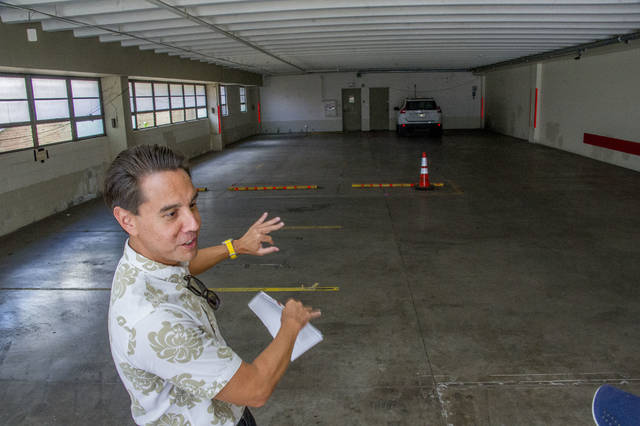Caldwell enacts law pushing sit-lie ban to additional areas

CRAIG T. KOJIMA / CKOJIMA@STARADVERTISER.COM
On Kuwili Street in Iwilei, Mayor Kirk Caldwell on Thursday signed into law Bill 13 CD 1, authored by City Councilman Joey Manahan, which expands the city’s sit-lie law to include certain commercial and industrial areas of Iwilei and Kalihi.

CRAIG T. KOJIMA / CKOJIMA@STARADVERTISER.COM
City Councilman Joey Manahan, author of Bill 13 CD 1, stood Thursday in the garage of the building at 431 Kuwili St., which will be the new city Hygiene Center.

CRAIG T. KOJIMA / CKOJIMA@STARADVERTISER.COM
Homeless structures line Iwilei Road.



Mayor Kirk Caldwell signed a bill into law Thursday that expands the city’s controversial sit-lie enforcement zones into Iwilei and additional parts of Kapalama.
Caldwell, flanked by city officials, area business owners and residents, said at a news conference in Iwilei that the city’s sit-lie law works in commercial areas where homeless encampments have adversely affected businesses despite efforts by the city and social service providers to offer help. He said Oahu’s homeless population, which increased slightly to 4,959 in January from 4,940 in January 2016, would drop under what he called “compassionate disruption.”
“We believe that compassionate disruption does work, that letting people know they cannot take over a sidewalk or park or road for other uses than what they were designed for is inappropriate, and we will use the laws to make sure that doesn’t happen,” he said.
The city’s existing sit-lie ordinance covers 15 zones, including Waikiki, downtown-Chinatown, Ala Moana-Sheridan, Aina Haina-Hawaii Kai, Wahiawa and Waimanalo, where sitting or lying on public sidewalks is prohibited from 5 a.m. to 11 p.m. daily.
Bill 13, introduced by Councilman Joey Manahan, expands the city’s sit-lie ordinance to a section of Kapalama bordered by Waiakamilo Road, North King and Kohou streets, and Dillingham Boulevard. It also creates another enforcement zone comprising sections of Iwilei Road and Sumner, Pine and Kuwili streets. Honolulu police will issue warnings over a 30-day period to the homeless in those areas before handing out citations, said Capt. Stephen Silva of the Kalihi patrol district.
Manahan said the bill was a culmination of nearly two years of working with the community, the city, law enforcement and service providers to try to get the homeless off the streets. He said businesses have suffered because of the growing encampments and the violence that has come with them. But he acknowledged that some of the homeless “are going to move somewhere else,” adding that sit-lie is not a permanent solution.
Don't miss out on what's happening!
Stay in touch with breaking news, as it happens, conveniently in your email inbox. It's FREE!
“There are always the chronic homeless. It’s still difficult for them to move into a permanent type of (housing) solution,” he said. “We haven’t found that silver bullet yet. (But) until then we have to turn to sit-lie. That’s the tool we have now.”
Susan Morita, manager of Menehune Mac on Waiakamilo Road, said she started to notice a gradual influx of homeless people moving into the area after the city fenced off the Kapalama Canal about two years ago. She said the business has faced problems, including numerous incidents of property damage due to the homeless in the area. One man repeatedly rammed a grocery cart into one of the building’s pillars, and others take gallons of water from the faucet, she said.
She said “only time will tell” whether the sit-lie law will provide some relief.
“We know this is not a fix to the problem. This is only a mere Band-Aid because they (homeless) have to go somewhere,” Morita said. “We want to make sure they’re treated properly. (But) we have to make sure of our customers’ and workers’ safety.”
Tiffany Lizares, co-owner of Technics Jiu Jitsu and Lino Hau Jewelry, described repeated instances of drug activity, the homeless urinating on private property, and violence near her business in the Kapalama area. She called the sit-lie law long overdue.
But the bill and other sit-lie laws have faced challenges from ACLU Hawaii, which has testified before the Council that the ban merely shuffles homeless from one area to another. Mandy Finlay, the nonprofit’s advocacy coordinator, had told Council members that the bill would unlawfully criminalize homeless people and that a better way to address the issue would be to invest additional funds into homeless projects and programs. Those concerns have also been raised by some Council members.
“The ACLU of Hawaii does not dispute that the general public has a right to use public spaces, including sidewalks,” Finlay said in written testimony submitted last month. “Bill 13, however, goes too far: There are effective ways to keep sidewalks clear short of putting all homeless individuals in prison for up to a month at a time. Bill 13 does nothing to address Honolulu’s homelessness problem.”
Connie Mitchell, executive director of the Institute for Human Services, said several of the homeless in Iwilei have refused help or have moved into shelters only to get kicked out for breaking the rules. She said there are about 50 to 60 homeless living in the Iwilei area but that the number can spike to about 75 to 100.
Mitchell acknowledged that some who refuse help will be forced to move to different areas, but said the nonprofit can track them and continue offering services through partnerships with other agencies.
“We really feel like our offering of services is sort of like hand in hand with the enforcement,” she said. “Each of those citations is a referral to us. It’s letting us know that this person needs help.”



